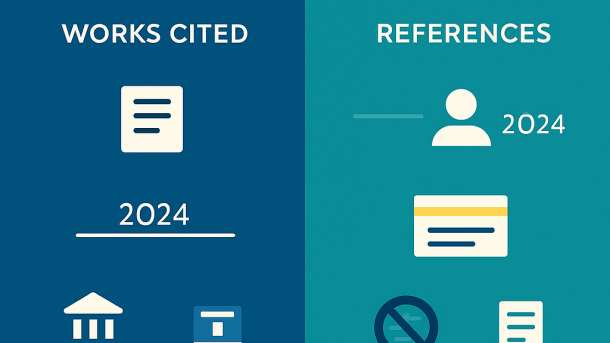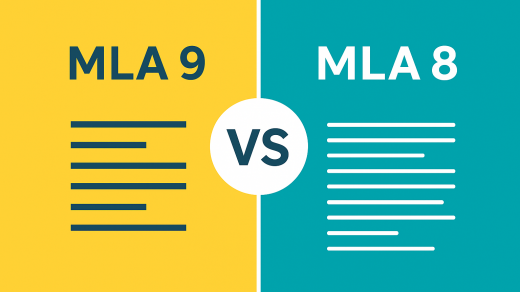Use MLA for humanities (literature, languages, cultural studies) and APA for social and behavioral sciences. MLA favors the author–page system and a Works Cited list; APA uses author–date with a References list, foregrounding the year. Differences also appear in title pages, headings, running heads, capitalization, and DOI/URL formatting.
Table of contents
-
MLA vs. APA at a glance (2025)
-
When to use MLA or APA
-
Formatting the paper: pages, headings, and page headers
-
In-text citations: author–page vs. author–date
-
Reference lists: Works Cited vs. References (with examples)
MLA vs. APA at a glance (2025)
Big picture: MLA (9th ed.) is optimized for analyzing texts where page location matters; APA (7th ed.) emphasizes recency and methodological clarity, so year is central. The table below captures 10 differences students must know.
| Aspect | MLA (9th edition) | APA (7th edition) | Why it matters |
|---|---|---|---|
| Primary disciplines | Humanities (literature, languages, cultural studies) | Social/behavioral sciences (psychology, education, business, nursing) | Choose the style aligned with your field. |
| In-text system | Author–page: (Morrison 112) | Author–date: (Bandura, 1997) | APA spotlights when the research appeared. |
| Year emphasis | Year usually appears only in Works Cited | Year appears in every in-text citation | Signals currency and chronology in APA. |
| Reference list label | Works Cited | References | The label at the top of the final list differs. |
| First page / title page | No separate title page by default; heading on first page | Separate title page required for most student/pro papers | Affects your document’s opening section. |
| Running head / page header | Last name + page number at top right | Page number top right; running head only for professional papers | Don’t add APA running head unless required. |
| Section headings | Optional; flexible (H1–H5 not standardized) | Structured levels (1–5) with specific formatting | APA expects a hierarchy for longer papers. |
| Capitalization of titles in list | Title case for works; quotes/italics depend on source type | Sentence case for article titles; Title Case for journals | Capitalization rules differ at a glance. |
| DOIs and URLs | Shown as available; “https://doi.org/…” form accepted | Prefer https://doi.org/; show live URLs; no “Retrieved from” unless needed | Standardized, clickable identifiers in APA. |
| Abstracts & keywords | Abstract not typical for student essays | Abstract and keywords common in professional papers | Required in many APA scholarly contexts. |
Bottom line: If your instructor doesn’t specify, align with the discipline, then check the in-text system you’ll be most comfortable maintaining throughout.
When to use MLA or APA
Use MLA when your assignment centers on close reading, rhetoric, or textual analysis. The page number in the in-text system makes it easy to direct readers to exact passages in novels, plays, or essays. MLA is also forgiving about headings in shorter papers, which suits many literature and composition courses.
Use APA when your course foregrounds empirical evidence, dates, and methods—for instance, psychology reports, classroom action research, or nursing literature reviews. The author–date signal lets readers instantly judge timeliness and cross-reference the References list for methodology or measures.
If your discipline overlaps (e.g., media studies, communication, education), default to APA unless your instructor requests MLA. Program or journal guidelines always override generic rules.
Practical tie-breakers for students:
-
Citation inputs you already have. If your sources include strong page markers (PDFs, print books), MLA can feel natural. If you’ve logged publication years carefully, APA is smoother.
-
Document type. For short interpretive essays, MLA keeps setup simple (no title page). For reports, proposals, literature reviews, APA’s title page, headings, and abstract improve readability.
Formatting the paper: pages, headings, and page headers
Shared foundations: Both styles expect 1-inch margins, double spacing, a readable serif or sans-serif font (12-pt Times New Roman, 11-pt Calibri, 11-pt Arial are typical), and left alignment with a ragged right edge. Indent the first line of each paragraph by 0.5 inch.
First page vs. title page
-
MLA: On the first page, place your name, instructor, course, and date, followed by a centered paper title in Title Case. No extra bolding or underlines. Start the essay on the next line.
-
APA: Create a separate title page. Center the paper title, author, institution, course, instructor, and due date (for student papers). Add a page number in the header on every page. Abstracts are typical for professional papers and many upper-level assignments.
Page headers
-
MLA: Put your last name and page number in the header, top right, on all pages including the first.
-
APA: Put just the page number top right for student papers. A running head (shortened title, all caps, left header) is used mainly in professional manuscripts when required.
Headings inside the paper
-
MLA: Headings are optional and stylistically flexible. Use them sparingly in short essays. Keep capitalization consistent (Title Case for headings is common practice).
-
APA: Headings follow a five-level system. Even if your paper only needs Levels 1–2, the hierarchy helps readers navigate literature reviews, methods, and results.
Quick setup in Word/Docs (minimal steps)
-
Set margins to 1 inch and double spacing; choose a standard font.
-
Insert a page number in the header (top right). In MLA, add your last name before the number.
-
Create either the MLA first-page heading or the APA title page as your course requires.
-
Apply consistent heading styles (APA levels or a modest MLA scheme) only where they improve navigation.
In-text citations: author–page vs. author–date
Core contrast: MLA tells readers where to look (page), while APA foregrounds when the source was published (year). Both styles value clarity and concision; both support narrative and parenthetical forms.
MLA narrative and parenthetical forms
-
Narrative: As Morrison argues, belonging is negotiated through memory (112).
-
Parenthetical: (Morrison 112).
-
Two authors: (Dyer and Hall 76).
-
Three or more authors: (Nguyen et al. 58).
-
No page numbers (e.g., web): include author but omit page or use a stable locator if available: (Rivera).
-
Multiple works by same author: add a shortened title: (Morrison, Beloved 112).
APA narrative and parenthetical forms
-
Narrative: Bandura (1997) describes self-efficacy as central to behavior change.
-
Parenthetical: (Bandura, 1997).
-
Two authors: (Smith & Lee, 2020).
-
Three or more authors: (Nguyen et al., 2021).
-
Direct quotes with page: (Smith & Lee, 2020, p. 76).
-
No author: use the title or organization: (“Mindful Study,” 2022) or (World Health Organization, 2020).
-
Multiple works, same author–year: suffix letters in References and in-text (Taylor, 2023a; Taylor, 2023b).
Signal phrases and flow
Integrate sources with signal verbs—argues, demonstrates, reports, shows, contends—and vary your structure. In MLA, add page numbers whenever they exist; in APA, include the year the first time you cite the author in a paragraph (and again as needed for clarity or when citing new works).
Quotations vs. paraphrases
-
Short quotes (fewer than 40 words APA; fewer than four lines MLA) stay in the paragraph with quotation marks.
-
Block quotations start on a new line, indented 0.5 inch, without quotation marks; place punctuation before the parenthetical citation in MLA and after the quote with the citation in APA. Use block quotes sparingly—your analysis should dominate.
Reference lists: Works Cited vs. References (with examples)
Naming and order
-
MLA “Works Cited”: alphabetized by author’s last name; hanging indent 0.5 inch. Titles generally in Title Case; container titles (e.g., journals) italicized.
-
APA “References”: alphabetized by author; hanging indent 0.5 inch. Sentence case for article and chapter titles, Title Case for journal names; include DOIs as URLs when available.
Books
MLA (print or stable page PDF)
Morrison, Toni. Beloved. Vintage, 2004.
APA
Morrison, T. (2004). Beloved. Vintage.
Journal articles
MLA
Hernandez, Luis, and Maya Patel. “Learning Across Contexts: A Review.” Journal of Educational Inquiry, vol. 28, no. 3, 2023, pp. 201–225. doi:10.1234/jei.2023.09876.
APA
Hernandez, L., & Patel, M. (2023). Learning across contexts: A review. Journal of Educational Inquiry, 28(3), 201–225. https://doi.org/10.1234/jei.2023.09876
Web pages (no author or organization author)
MLA (no individual author)
Mindful Study Habits. 2022, Site Name. Accessed 10 Aug. 2025.
APA (organization as author)
World Health Organization. (2020). Mental health and work: Key facts. WHO. https://www.example.org/mental-health-and-work
Edited collections (chapter)
MLA
Khan, Aisha. “Community, Culture, and Care.” Health Narratives, edited by James Liu, Blue Pine Press, 2021, pp. 77–96.
APA
Khan, A. (2021). Community, culture, and care. In J. Liu (Ed.), Health narratives (pp. 77–96). Blue Pine Press.
Why examples differ visually
Notice how MLA italicizes the container (book or journal) and uses Title Case for titles, while APA shifts to sentence case for article and chapter titles and standardizes DOIs and URLs. If you’re switching styles, focus on capitalization, year placement, and DOI formatting—these three areas cause the most lost points.
From draft to compliant references (micro-workflow)
-
Start with raw metadata (authors, year, title, publisher/journal, pages, DOI/URL).
-
Decide MLA vs. APA based on course rules.
-
Apply the right casing to titles and the correct label (“Works Cited” vs. “References”).
-
Generate a hanging indent and proofread author name order and initials.




